Scioly Ecology 2018: Desert and Grassland
1/117
There's no tags or description
Looks like no tags are added yet.
Name | Mastery | Learn | Test | Matching | Spaced |
|---|
No study sessions yet.
118 Terms
xerocoles
animals that can live in deserts
erg
sand dune region
largest desert in the world
antarctica - 5.5M square miles
also largest cold desert
xerophytes
desert plants
map of deserts
plus antarctica and arctic?
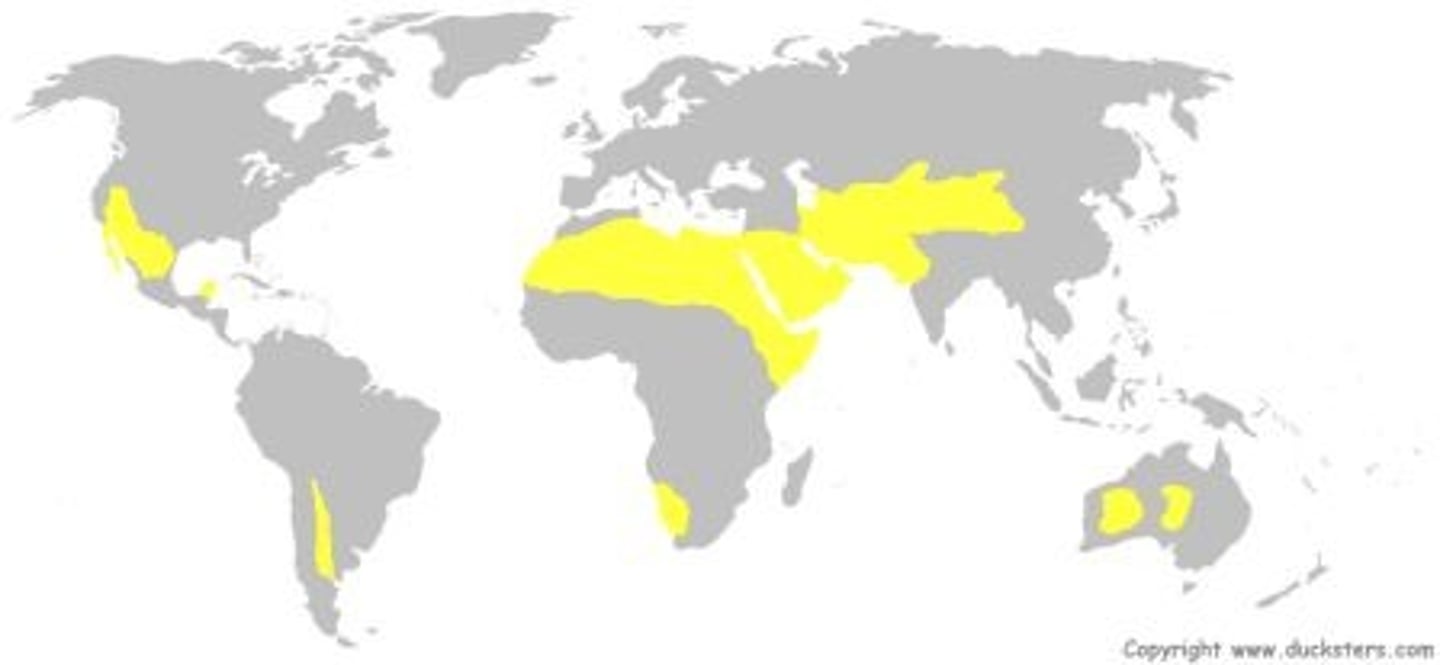
area of earth w/ desert
1/5 of earth's land
hottest temp ever
54C in death valley and also in kuwait
desert defn
less than 10in (25cm) of rain per year
where do grasslands form
in areas where too little precip for forest but too much for true desert
aridity index
A = P/PET = average annual precip/potential evapotranspiration
<0.05 = hyperarid
0.05-0.20 = arid
0.20-0.50 = semiarid
generalizations about grassland plant species
grasses of multiple species and genera but mostly dominated by a few species
most with rhizomes (underground spreading stems that send up shoots and nodes and store starches up to 1/2 of biomass); wind pollination; perennial bunchgrasses
will grow back after fire, grazing, wind, extreme temp
temperatures in grasslands
huge range from seasons often deep into the negs in winter (more to north), over 100 in summers
grassland precipitation
6-40in (15-100cm)
grassland precipitation season
scattered thunderstorms in summer but most rain/snow in winter and cooler times
grassland soils
mollisols (basic, hummus rich, dark, productive, Ca/Mg)
mollisols are most common soil type in US (21.5%) and 7% of ice free land worldwide
found in W great plains and scattered rest of west
grassland growing season
typically 120-200 days
grasslands topography
flat, some rolling hills, steep canyons
grasslands fire
frequent due to summer thunderstorms
necessary to maintain ecosystem and keep back trees and shrubs, grasses have survival mechs
grasslands fauna
grazing animals like deer, elk, bison in large herds
songbirds and small burrowing mammals very common
tallgrass prairie
usually around 1-3m (3-9ft), deep roots, nearest eastern deciduous forests
precip around 25-40in (65-100cm), usually around 34in
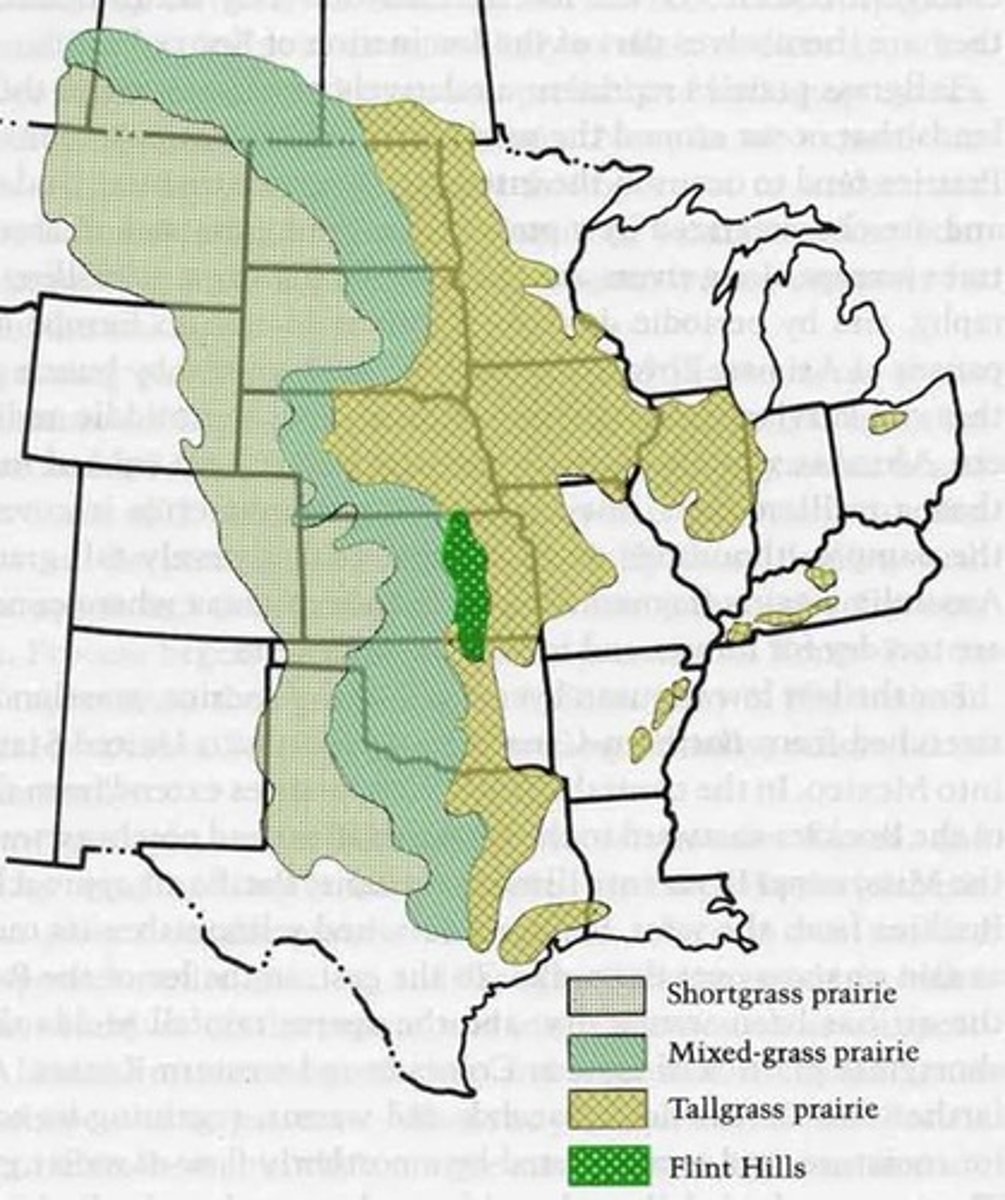
Tallgrass prairie problems
most plowed and planted w/ wheat/corn; increased drainage and runoff reduces moister areas
Tallgrass prairie plants
Big bluestem (image), sand bluestem, indian grass, slough grass, switchgrass

mixed grass prairie
usually under 4ft (1.3m) in height; usually around 3ft
precip around 14-25in (35-65cm)
mixed with taller grasses growing in slightly wetter areas and shorter ones in drier areas
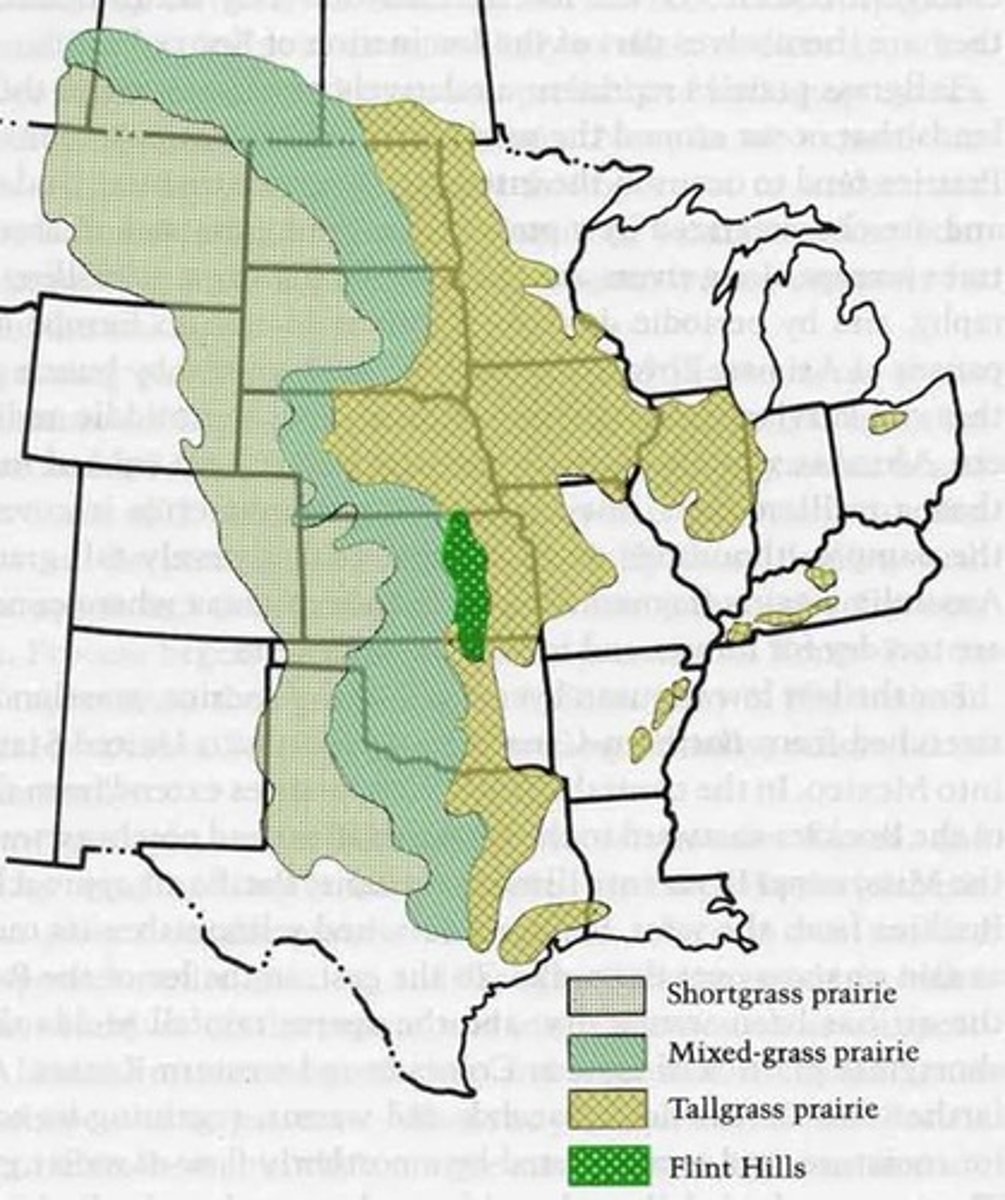
mixed grass prairie species
little bluestem grass, june grass, needle grass, dropseed grass, wheatgrass, wild rye
mixed grass prairie problems
almost entirely planted over with crops such as corn and soybean
shortgrass prairie
nearest to western deserts, cover most area of the 3 groups in N america; mostly W of latitude 100W
most less than 20in (50cm), usually below 1ft; fewer forbs because lower rain favor grasses; can't grow bigger bc no water
precip usually around 14-10in (25-35cm)
also called 'the plains'

shortgrass prairie problems
some takeover for irrigated corn and crops; mostly just overgrazed for cattle, fenced from native grazers, invasives on ranges
shortgrass prairies species
buffalo grass, galleta grass, needle grass, grama grass, penn sedge
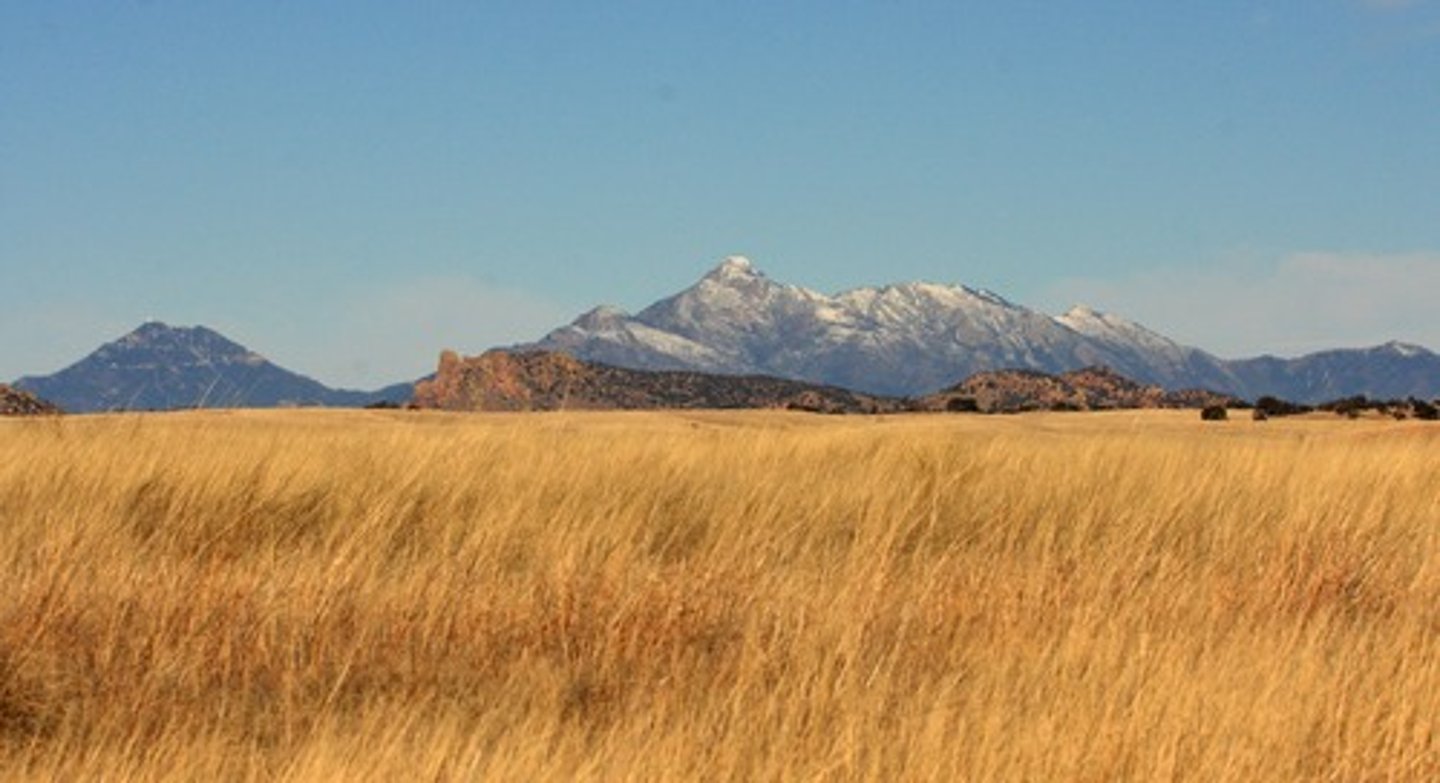
bunchgrass prairie
also called palouse prairie (near palouse river in WA)
found in plains N of great basin, colorado, UT, CA, WY, MT
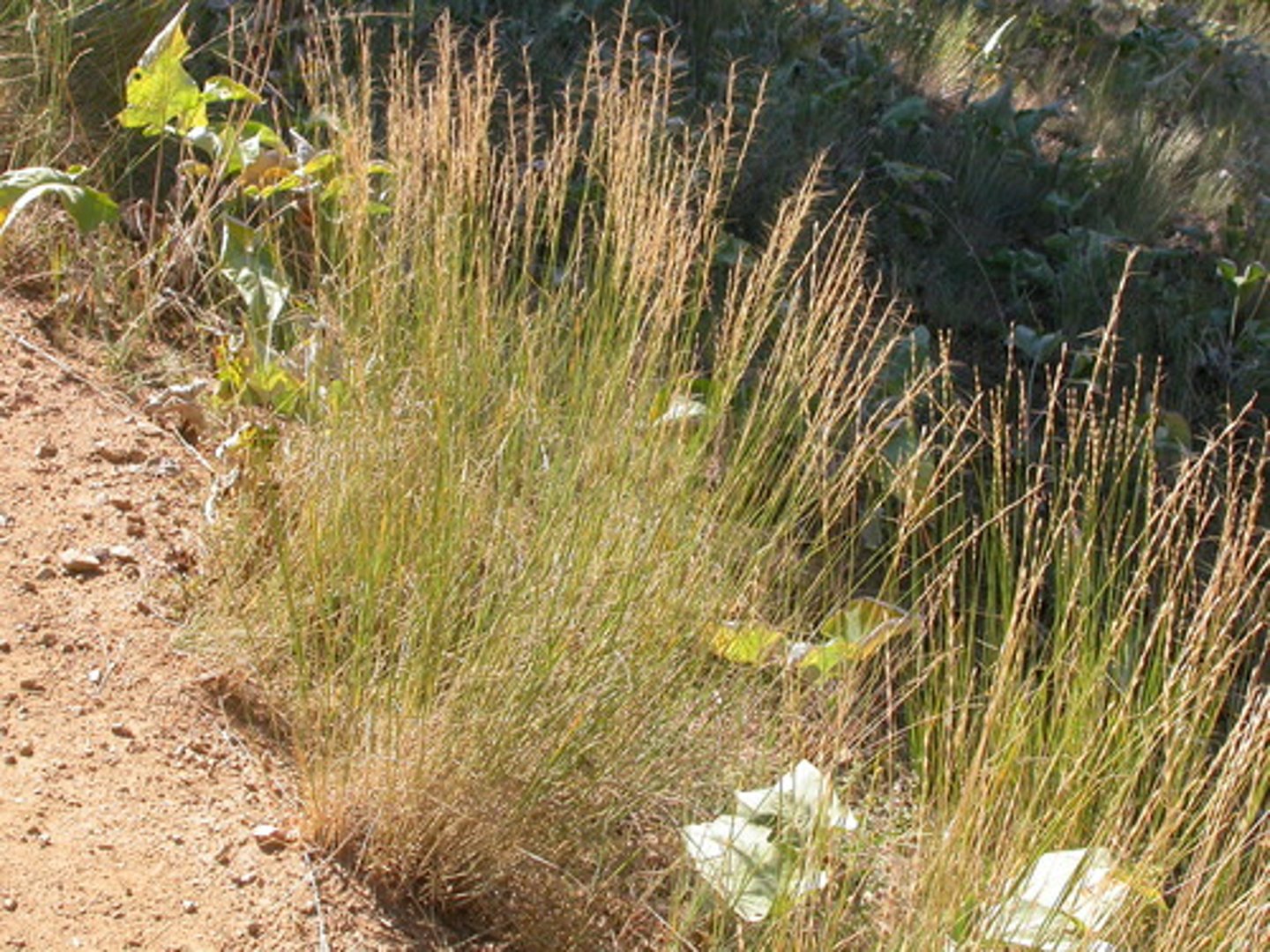
bunchgrass prairie species
purple needlegrass, sagebrush, bluebunch wheatgrass
bunchgrass vs. typical plains grass
bunchgrass sends up new shoots from its base forming a clump
Most prairie grasses have mat-like roots that spread and produce new shoots spread out from one another
characteristics of grassland grazers
wide set eyes, large herds, camoflage and speed, good vision,
characteristics of grassland birds
lots of them (lots of songbirds)
strong fliers due to high winds, nest in tall grasses,
characteristics of small grassland mammals
many in colonies, many burrow, many hop for visibility
desert soils
aridisols (parent material with buildups of minerals that would usually be leached like calcium carbonate)
SW and great basin; 8% of US, 12% world
some entisols (indistinguishable from parent material in W)
very little hummus but high in nutrients
grassland history
during pleistocene/miocene (50-3.5MYA) mountains in N amer make grassland climate more favorable
after pleistocene ice ages, drier/warmer climate expand grasslands
savanna
tropical grassland with few uniformly dispersed trees that aren't dense enough to form a closed canopy
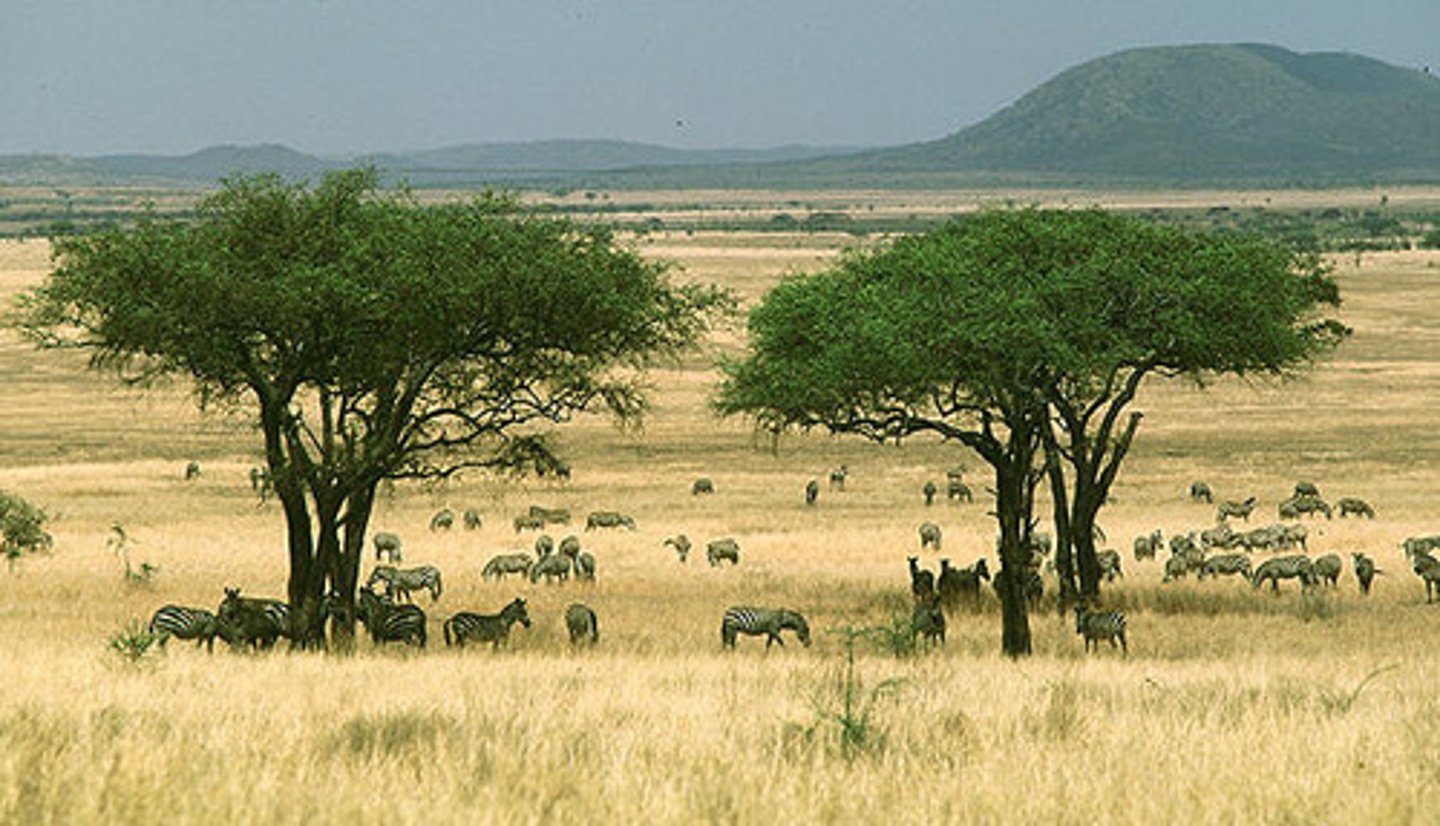
savanna reqs
20-50in of rain concentrated in 6-8 months followed by long hot drought where fires are common; average daily temp never drop below 64F
types of savanna
climactic savannas - classic all rain in one season and fire and drought maintain in rest of year
edaphic savannas - thin or clay soils that inhibit tropical forest growth
derrived savannas - human or elephant deforestation creates critical mass of grass to burn away tree sprouts
savanna plants
generally has a dominant grass or few grass/forb species and scattered deciduous trees
grasses: includes elephant grass which is like 10ft
trees: acacia, baobab, candelabra
savanna seasons
winter is dry starting October with strong winds, little rains, few lightning
summer is wet
savanna fires
during winter dry season
small animals in burrow, big out run, insects die, grades burn but roots ok
savanna problems
desertification, clearing for farming, poaching, overgrazing
grassland problems
clearance for farming/grazing, species disruption (poaching and overhunting/invasives), hunting
savanna locations
brazillian horn highlands, venezualan campos, sahel (lot thicker than shown), E africa and S africa, parts of india and SE asia; N australia
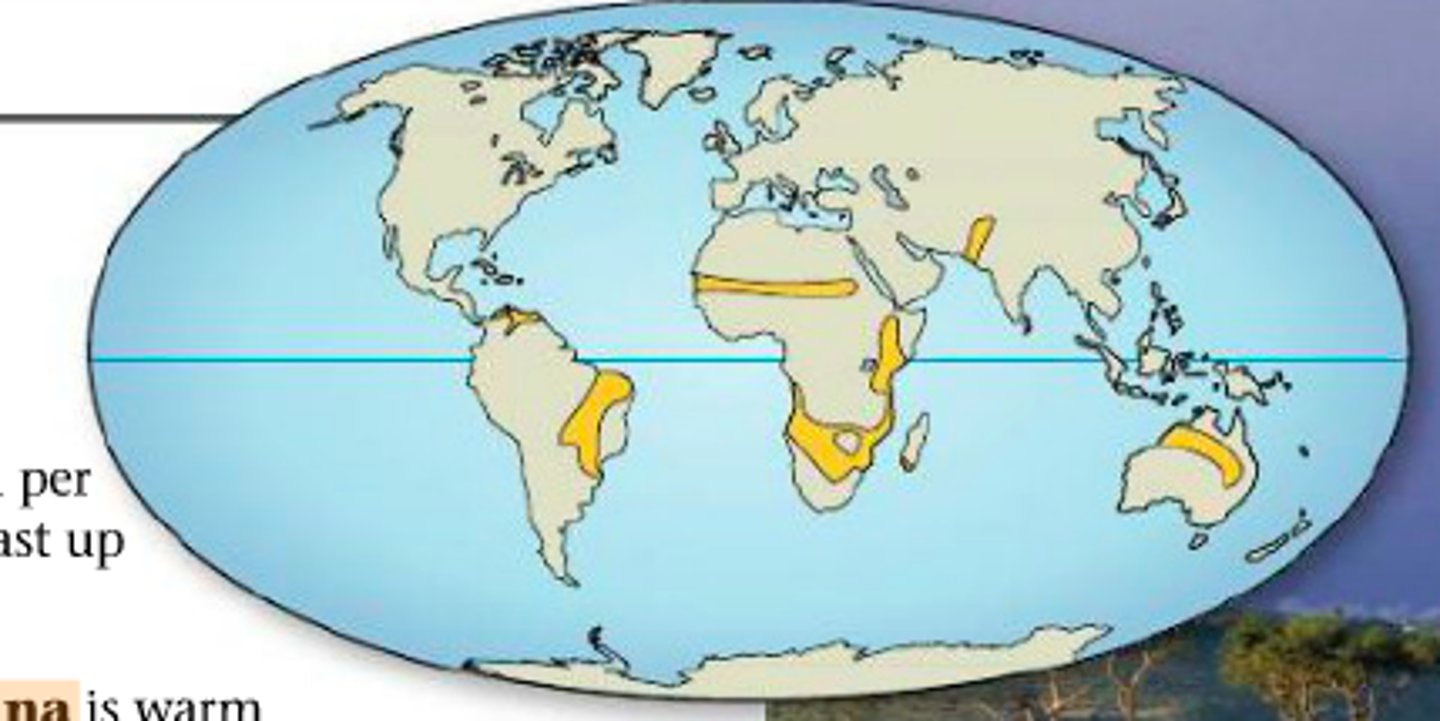
Derived savanna
much of the world's savanna is actually tropical forests that were cleared by people and then animals and fire maintained the grasses
veldts
grasslands of South Africa
puszta
grasslands of Hungary
temperate grasslands definition
clearly defined hot summer and cold Winters
temperate grasslands distribution
plains of US, pampas in Argentina, eurasian steppes from ukraine through balkash, mongolia and manchuria area, turkey

rainfall in temperate grasslands
moderate: 20-35in per year (more rain is taller grass)
mostly late spring early Summer
temperate grasslands soil
mollisols dark and Rich
savanna soils
rich ish but often leached
temperate grasslands fire
there is some fire in the drought season in fall or summer, but not as much or as important as savannas
temperate grasslands seasons
very hot summer and cold winter
rains in late spring and early Summer and drought for the rest of the year
trees in temperate grasslands
some riparian but basically nonexistent in actual grass unlike savanna
temperate grasslands Max and min temperatures
max over 100f min like -40
temperate grasslands problems
destruction for farming and grazing
steppe rain
10-20in in winter (30-50cm)
steppe problems
wheat and grazing destroying it, salinization from irrigation
desert fires
uncommon, most of the time there isn't enough vegetation
flash flooding mechs
earth is hard baked so all the water just runs off immediately after it falls
desert types
hot and dry
cold
coastal
semiarid
hot and dry desert
little rain but varies
mean temps 20-25C; often over 40C; can drop into -C
plants w/ thick cuticle and sometimes CAM; small animals (lizards mostly)
include major N amer deserts of mojave-chihuahua-sonoran-great basin, sahara, australia
semiarid desert
cooler (20-25 in summer, 10C at night, cooler winters); precip varies but more dew and condensation
gravelly in hills with hardpan bottoms
plants are larger shrubs like creosote; brickelbrush; somewhat more animals (small mammals)
cent asia, great basin, montana
precip in deserts
under 25cm; most in cool winter; precip varies but always low
coastal deserts
cool (15-20C in summers) summers and moderate winters; very little precip, often years between
atacama and namib
very dry adapted animals and plants
cold deserts
cold (below freezing winter, 20C in summer); higher precip (15-25cm) mostly as snow in winter; moister
higher elev great basin, antarctica/arctic
silty soil
the sun and deserts
lack of moisture means 90% of solar radiation hits ground vs. 40% in humid/tropical
bajada
alluvial fans merge into a gradual slope from mountains in desert to base
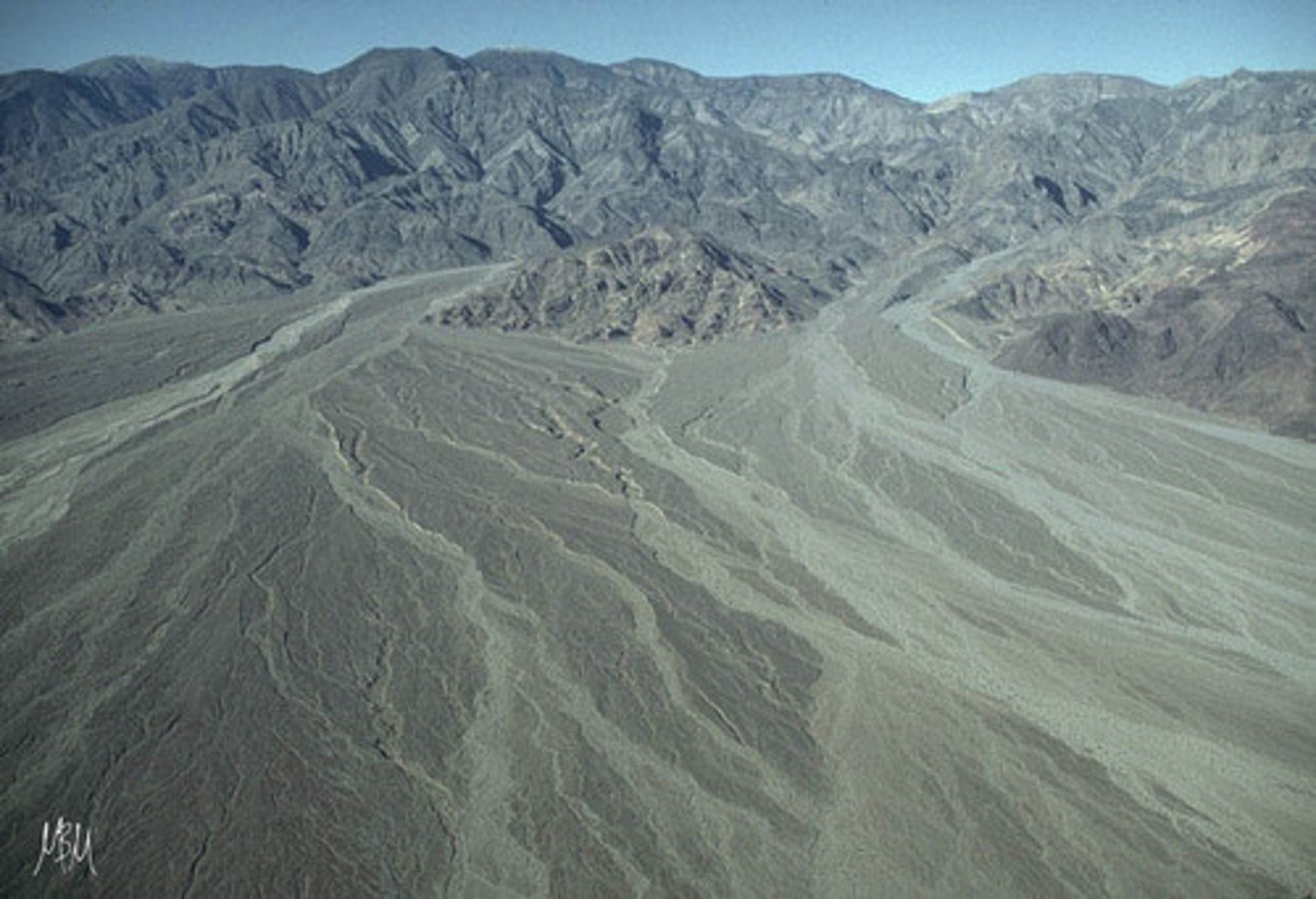
different names for grasslands
pampas, prairies, meadows, steppes, savannas, veldt,
largest intact savanna
N australia
list savanna types
tropical, temperate, mediterranean, montane, flooded
tropical savanna
synonymous with typical savanna
temperate savanna
sketchy term to describe any temperate grassland with sparse trees and shrubs
mediterranean savanna
savannas in mediterranean climates with interspersed trees (med, socal)
ie: oak savannas
flooded savannas
usually tropical savannas that are flooded part of the year like the pantanel or the okavango
alpine savanna
or montane savanna; found above the tree line high up in equitorial areas, elsewhere is just alpine grassland; same as alpine tundra?
alpine grassland
found above the treeline or polar direction from treeline but not in permafrost
mostly tussock fescue grasses where temperature never tops 50F in summer
drops 6.5C for every thousand feet up of 3 degrees?
successional grasslands
grasslands maintained by fire and grazing and disturbances that would otherwise be taken over by trees and shrubs
temperate vs. savanna
mostly by distance from equator (savanna usually between tropic of capricorn and cancer)
savannas have trees and shrubs while temperate typically little to none
climate: rains and temps
savanna woodland
tree canopy covers >50% of area
savanna parkland
20-50% of area is covered by tree/shrub canopy
savanna grassland
<20% of the area is covered by trees/shrubs
prairie
name given to US grasslands
california grasslands
used to be sagebrush steppes in owens valley and NE and stipa pulchra (purple needlegrass) bunchgrasslands through central and Socal
bunchgrasses disappeared
steppe
refers to european grasslands; treeless entirely; dry (30-50cm); drought common, feather grasses dominant (feathery flowers, mostly stipa); cold winter, moderate summers where they get most of rain; grasses die back in august and don't revive until spring
steppe climate
dry (30-50cm); drought common summer-autumn; precipitation distributed with rain in summer and some snow in winter but dries out fast in summer rains
cold winters below freezing for 5 months; moderate summers up to around 70's (F)
steppe plants
dominated by feather grasses (stipa sp); fescue (festuca), oats (avena), sedges (carex), bluegrass (poa bulbosa), tulips (tulipia), sagebrushes (artemisia)
forest steppe
where the steppe meets the northern boreal forests in a transition zone where trees more and more dense as north; N of meadow steppe
meadow steppe
moister climate; more sedges and feathergrasses (needlegrasses/stipa), often used for livestock
south of forest steppe, north of dry steppe
Dry steppe
ground is dry most of the time because rainfall less than amount that can evaporate; mostly shorter feathergrasses/needlegrasses and fescues
merges with desert to south and meadow steppe to north
types of steppe
forest steppe: as steppe merges with taiga to north
meadow steppe: wetter steppe S of forest steppe
Dry steppe: drier steppe merging into deserts
pampas
south american grasslands in rio de la plata region, Uru and Arg mostly
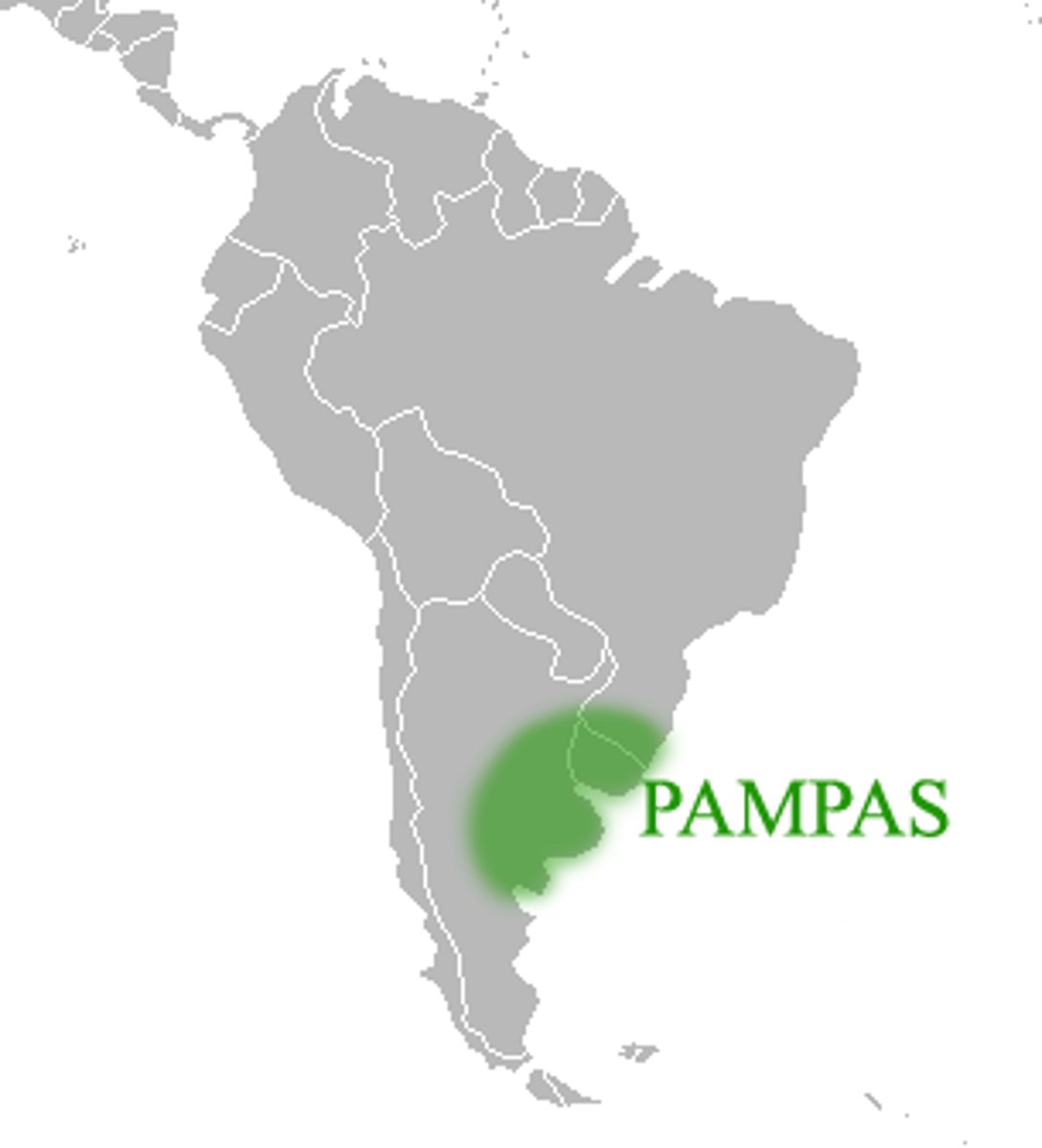
pampas climate
warm summer about 30C and cool winter around 15C; rain varies from 20-40in
sterile pampa
dry plain that can give way to deserts; found to western portion up towards andes; salty soil; dominant plants are thornbrushes (ie: chanal); rain around 20in
eastern pampas
wetter side closer to sea around 30-40in precip; very productive ag land; dominated by pampas grass (same one invasive in CA), few forbs inbetween but pretty dominant; high fire frequency kills most trees except ombu

veld
extends high into mountains; mostly in E S africa and lesotho; rain 20-40in
types of veld
high veld towards central in high elevation areas
bushveld is dry savanna-like
cape middle veld is to west of high veld in the middle of S africa
sweet veldt is areas with <25in rain where grasses retain nutrients through winter
sour veld is wetter areas where pull in water during winter dry season
veld plants
dominated by red oat grass; bermuda grass, others; mostly taken over by crops like corn now